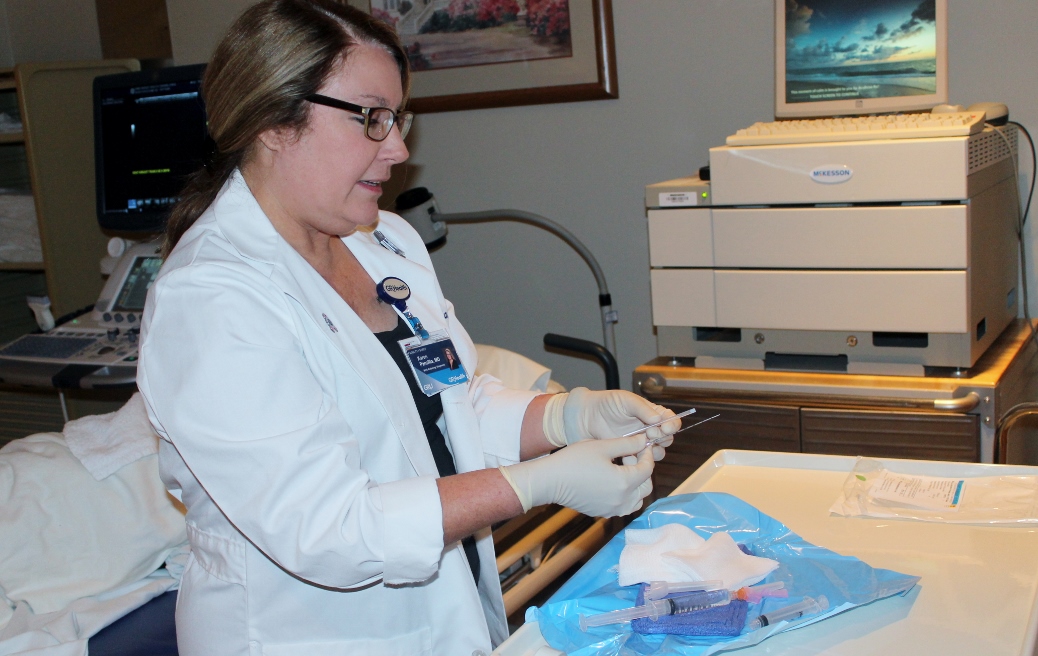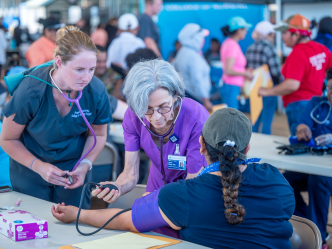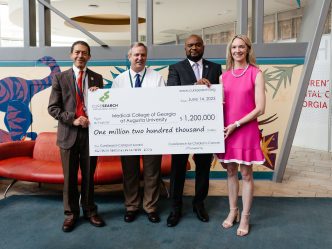AUGUSTA, Ga. – Tiny radioactive seeds are helping surgeons more precisely remove breast tumors and perform biopsies. Using a technique called radioactive seed localization, or RSL, non-palpable breast tumors or lesions targeted for biopsy are marked with a small pellet loaded with a miniscule amount of radioactive material. Later, when the patient is in the operating room, the breast surgeon uses a radiation detector to more accurately locate and remove the target lesion.
“My go al is to make the incision as close to the target area as possible. The seed takes the guesswork out of locating that target area,” said Dr. M. Firdos Ziauddin, a breast surgeon at GRU Cancer Center. “I prefer this method because the localization is more precise.”
al is to make the incision as close to the target area as possible. The seed takes the guesswork out of locating that target area,” said Dr. M. Firdos Ziauddin, a breast surgeon at GRU Cancer Center. “I prefer this method because the localization is more precise.”
During a brief outpatient procedure, a radiologist uses a thin needle to inject a tiny seed into the abnormal tissue.
“It only takes about five minutes to inject the seed and confirm its placement by ultrasound or mammogram,” said Dr. Karen Panzitta, breast radiologist and lead mammographer at the Breast Health Center at Georgia Regents Medical Center. “This approach is especially helpful for small, non-palpable tumors that can only be detected during mammograms; tumors so small, they cannot be felt by touch during a breast exam.”
The seed – about the size of a sesame seed and the color of pencil lead, and containing an isotope of iodine – emits a very low-dose of radiation that acts as a beacon during surgery, helping Ziauddin accurately locate and remove the target lesion, the seed, and portions of surrounding breast tissue.
The alternative to RSL, and still the most widely used approach, is wire localization. With this technique, the radiologist inserts a thin, hooked wire into the breast to help mark the location of the target lesion. While one end of the wire is lodged at or near the lesion, the other end protrudes from the patient’s breast.
“It’s not very comfortable or convenient for a patient to have a wire sticking out of her breast,” Panzitta said, “especially if the patient has to wait for surgery for several hours or even overnight.”
Ziauddin agrees.
“From a patient’s perspective, there is a definite advantage with RSL in terms of convenience, because the seed can be placed a few days ahead of surgery. On the actual day of surgery, the patient can spend less time hungry and thirsty because she can go directly to surgery without having to spend the time having a wire placed. There is also less concern about the seed being dislodged than the wire being dislodged or removed,” he said.
Radioactive seed localization can allow for a better cosmetic outcome as well, experts say, because surgeons can find the least difficult and most direct approach to the area in question.
“RSL has about a 95 to 98 percent success rate, so the likelihood of removing all suspect tissue has been significantly improved,” said Panzitta. “This helps us put our patients more at ease about the outcome.”
Patients also need not be concerned about radiation exposure from the seed, she said, because its use is highly regulated.
“The medical team works closely with the hospital’s radiation safety experts to protect patients, as well as the medical staff, from unnecessary exposure,” Panzitta said.
Experts liken the radiation dosage to be about the same amount that a person would be exposed to on a two-hour airplane ride. Furthermore, the seed is strictly used for tumor marking and does not replace radiation or chemotherapy for treating cancer.
Breast cancer is the second-leading cause of cancer death among women. The American Cancer Society recommends an annual mammogram paired with a clinical breast exam for women 40 and older.
In recognition of Breast Cancer Awareness Month, the Breast Health Center is offering patients a chance to schedule a mammogram for any Saturday in October between 8 a.m. and 1 p.m. by calling 706-721-9729 (XRAY). The Center is located on the first floor of the hospital at 1120 15th St.
About the Breast Health Center
The Breast Health Center at Georgia Regents Medical Center is an American College of Radiology Breast Imaging Center of Excellence and the first and only center in the area using 3-D mammography, also known as tomosynthesis, which has been shown to improve cancer detection and reduce false-positive results. In addition, the Center, which performs more than 6,000 mammograms each year, was recognized in 2013 with a Patient-Centric Imaging Award by Health Imaging Magazine. Visit the Breast Health Center for more information.
About the GRU Cancer Center
The GRU Cancer Center is a multi-disciplinary academic cancer center whose mission is to reduce the burden of cancer in Georgia and across the globe through superior care, innovation and education. Its patient-centered approach includes first-in-the-nation treatment protocols, an experimental therapeutics program and specialized clinics for Phase I trials and immunotherapy. A multidisciplinary team of experts in The Breast Program at the GRU Cancer Center specialize in the evaluation and treatment of benign breast disease and breast cancer. Last month, the Breast Program earned accreditation by the National Accreditation Program for Breast Centers from the American College of Surgeons. Visit the GRU Cancer Center for more information.
 Augusta University
Augusta University




